Congratulations Georgetown. Now It’s Time to Own Up to the Racist History of the Catholic Church.
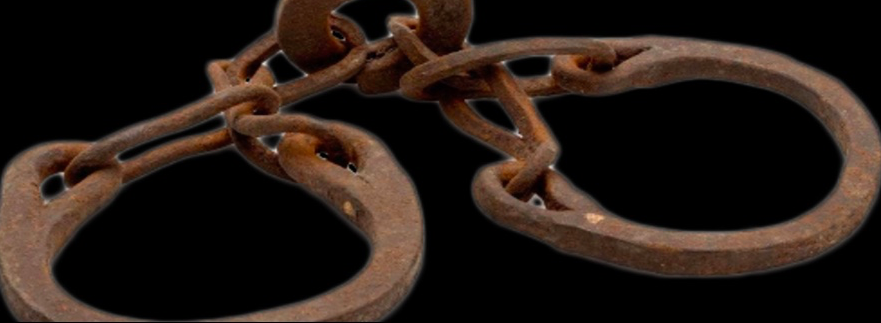
Banner Image - By Collectie Stichting Nationaal Museum van Wereldculturen, CC BY-SA 3.0.
The recent unveiling of Georgetown University’s plan to atone for its now infamous sale of 272 enslaved men, women, and children in 1838 to settle the institution’s financial debts has provoked a host of responses ranging from enthusiastic praise to outright disgust. While criticism of the university’s decision not to provide direct financial compensation to the living descendants of its former slaves or even include them in their final decision-making process is certainly warranted, the significance of the nation’s oldest Catholic institution of higher education affirmatively responding to student protests in the age of Black Lives Matter and actively seeking to investigate and make reparation for its historical ties to chattel slavery cannot be overstated. Considering the Catholic Church’s abysmal record on race relations and its enduring ambivalence on the specific matter of racial justice for black people, few could have anticipated that the university’s plan of action—which includes the creation of an institute for the study of slavery and its legacies—would go as far as it did.1 Fewer could have imagined that it would include a provision to honor and institutionalize the memory of one of America’s earliest black Catholic sisters.
Although African-descended women pioneered religious life for African Americans in the nineteenth century slave South and desegregated scores of historically white Catholic institutions—including colleges and universities—in the twentieth century, much of the history of African-American religious women—Catholic nuns and sisters—remains unknown and unwritten. In several documented cases, their lives and labors have been deliberately erased from the annals of church history in the name of white supremacy.2 This is especially true of America’s black sisters whose lived experiences of Catholicism intersect with the church’s brutal sin history of chattel slavery, colonialism, and racial apartheid. As such, the recommendation of Georgetown’s “Working Group on Slavery, Memory, and Reconciliation” to re-name Remembrance Hall (formerly McSherry Hall) after Oblate Sister of Providence Mary Aloysius (Anne Marie) Becraft constitutes a remarkable step forward in the long African-American struggle for recognition in the Catholic Church. It also holds the greatest potential to expose just how deep Georgetown’s ties to chattel slavery run and what the church specifically owes to its longstanding, but severely marginalized, African-American constituency.
Like so many African-descended women and girls who dared to embrace the celibate religious state in the modern era when whiteness became synonymous with holiness and blackness with evil and moral debasement, Becraft constitutes a dangerous memory for the Catholic Church. Although her story does not begin in slavery—like many of her counterparts—Becraft’s life as a pioneer educator of black girls in Washington, D.C. and early membership in the Oblate Sisters of Providence, the first successful black sisterhood in the western world, is deeply intertwined with Georgetown’s slaveholding past.3 Born into a prominent free black Catholic family in D.C.’s Georgetown community, Becraft was the paternal granddaughter of a free woman of color who worked as a housekeeper for Charles Carroll of Carrollton, one of Maryland’s wealthiest slaveholders and the only Catholic signer of the Declaration of Independence.4 Charles Carroll was also the cousin of John Carroll, the nation’s first Catholic bishop and founder of Georgetown University.5 Although the name and birth origins of Becraft’s grandmother have seemingly escaped the historical record, it is known that Charles Carroll presented Becraft’s father, William, with several of the Carroll family’s prized relics, paintings, and other keepsakes just before Carroll’s death in 1832.6 Considering the historical reality that many free women of color who served as housekeepers to America’s founding fathers were also their concubines, it is more likely than not that Becraft’s ties to the Carroll family, and thus Georgetown, are also biological.
Although it is unclear if Georgetown is currently aware of Becraft’s specific connection to the university, it certainly should come as no huge surprise. After all, the Catholic Church was the largest corporate slaveholder in the Americas. As such, thousands of contemporary African-American Catholics can trace their lineage to the enslaved men, women, and children who quite literally built and funded the early American church. Some even have intimate, and likely biological, ties to some of the nation’s oldest and most prominent white Catholic families, including the Carrolls of Maryland and the Spaldings of Kentucky. What should certainly bring about deep contemplation and additional reparation is the reality that so many African Americans retained the faith of their enslavers and routinely endured the humiliating practices of racial segregation and exclusion enforced in white Catholic institutions in hopes of a better day. As pioneer black Sister of St. Joseph Melinda Pellerin—a descendant of Catholic slaves in southern Louisiana—recently put it to me, these were the faithful who always “knew what the church could be.”7 They also gave the white-dominated church several of its pioneering African-American priests, brothers, monks, and more than anything else: sisters.
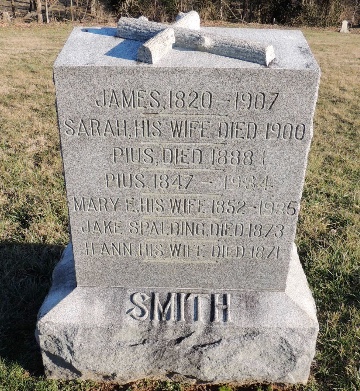
Tombstone of Pious and Mary Eliza (Spalding) Smith at St. Augustine Church Cemetery in Lebanon, KY
St. Augustine Cemetery in Lebanon, KY, for example, is the final resting place of several enslaved black Catholics who built the nation’s earliest convents, monasteries, and churches in Kentucky’s Catholic Holy Land, and their descendants. The interred include Pious Smith (1847-1934), who labored on Kentucky’s famed Abbey of Gethsemani, and his wife Mary Eliza Spalding Smith (1852-1935), who was the former slave of Leonard Augustine Spalding (1806-1888), uncle of Bishop John Lancaster Spalding, a co-founder of the Catholic University of America.8 Their specific line gave the nation its first African-American SVD priest and Trappist monk in Father Mary Simon (Vincent) Smith, O.C.S.O., and Sister Mary Kendra Bottoms, the only African-American Sister of Notre Dame currently ministering in Cleveland, OH.9 Their extended family gave the Church at least one additional black priest, one Sister of the Holy Family, three Franciscan Handmaids of the Most Pure Heart of Mary, and a pioneer African-American Sister of St. Joseph of St. Mark in Cleveland, OH.10
In the case of Georgetown, the Becraft family, which actually had two daughters become Oblate Sisters of Providence in the 1830s, is only the tip of the iceberg.11 Beyond the famed Healy clan, which surreptitiously gave the Jesuits its first African-American member in former Georgetown president Father Francis Healy, the descendants of William Lee, an emancipated slave of the Jesuit Fathers at Georgetown, are certainly deserving of greater investigation and recognition.12 Unlike the Healy children, who never embraced the black heritage of their enslaved mother and steadfastly avoided associations with the African-American Catholic community, the Lees are among the best representatives of those striving black Catholic families who kept the faith in the face of strident white racism and fought to make the church truly catholic.
Following the abolition of slavery, William Lee and his wife, Mary, another Catholic ex-slave, moved the family from D.C. to Philadelphia, where their son John Aloysius Lee, became just the second African-American graduate of a Catholic diocesan high school in the city. John eventually became a postal worker and prominent layman in Philadelphia’s archdiocese.13
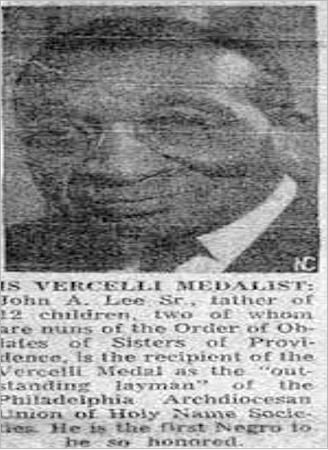
In 1955, John Aloyisus Lee, Sr. became the first black person to be awarded the Vercelli Medal of the Holy Name Society
(Unidentified Newspaper Clipping, Courtesy of the Archives of the Oblate Sisters of Providence)
John and his wife, the former Mary Susan Miller, also had twelve children, two of whom became women religious. Barred from entering every Catholic sisterhood ministering in the Philadelphia archdiocese solely on the basis of race in the late 1940s, Susan Grace and Bertha Amelia Theresa Lee eventually entered the Oblate Sisters of Providence in 1947 and 1949 respectively. Both remained in the historically black order until their deaths.14
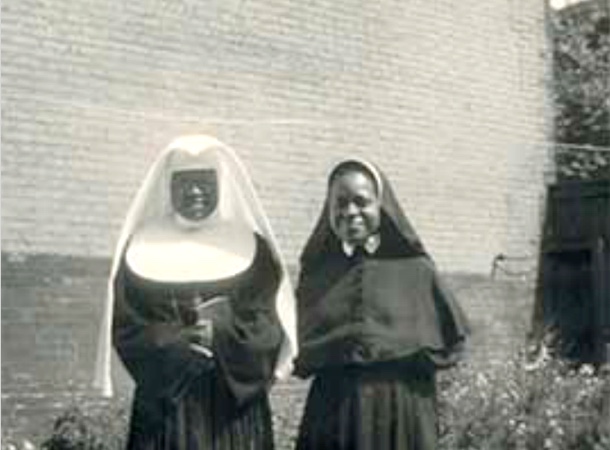
Sisters Mary Paul (Susan Grace) and Sister Mary Agnes (Bertha Amelia) Lee in the 1950s, courtesy of the Archives of the Oblate Sisters of Providence. Mary Agnes died in 1961. Mary Paul died in 2004.
In 1956, the Lees’ granddaughter, Cora Marie Billings, finally broke the racial bar in female religious life in Catholic Philadelphia when she desegregated the city’s branch of the Religious Sisters of Mercy. Like many pioneering black sisters in white congregations, Billings endured unspeakable racial discrimination in her early decades in the order. In 1968, Billings and her aunt Sister Mary Paul (Susan Grace) Lee served as founding members of the historic National Black Sisters’ Conference, which was organized to protest rampant anti-black racism in the Church and preserve black Catholic education. In 1990, Billings became the first black nun to lead a U.S. parish after being appointed to serve as the pastoral administrator at St. Elizabeth’s Catholic Church in Richmond, Virginia.15
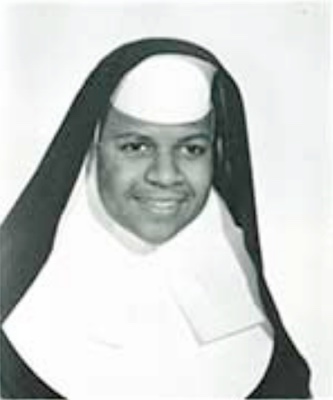
Sister Marie Immaculate (Cora Marie) Billings, R.S.M., c. 1957, courtesy of the Sisters of Mercy of the Americas, Mid-Atlantic Community Archives, Pennsylvania. Billings is still alive and preparing to celebrate her 60th jubilee as a member of the Religious Sisters of Mercy.
Such stories of black resilience and faithfulness in the face of unholy white discrimination are commonplace in American Catholic history. However, they are not widely known outside of the African-American Catholic community. As such, Georgetown’s plan of action represents an unprecedented opportunity for meaningful investigation into the church’s slaveholding past and its enduring legacy of anti-black racism. Hopefully, it will encourage other Catholic entities, especially the Vatican, to follow suit quickly.
To date, few Catholic institutions have acknowledged, let alone apologized for, their slaveholding pasts.16 Fewer, including Georgetown and the Jesuits, have done the same for their longstanding anti-black admission policies and other violent practices of white supremacy, which have kept the African-American Catholic population low and severely circumscribed to the present day.17 Indeed, if the Catholic Church at large is seriously invested in atoning for its racist past and present, then it will finally have to say with its words and actions that black lives matter and have always mattered even when the universal church acted as if they didn’t. The church will also have to take seriously the largely suppressed history of black Catholics, who currently make up one-fourth of its global faithful. And to be clear, the lives and labors of black sisters are a good place to start.
________________
1 Although the Vatican has apologized for the Catholic Church’s involvement in the slave trade, no Pope has ever apologized for the Church’s rampant slaveholding or its longtime enforcement of white supremacy in its institutions around the world. Most recently, Pope Francis conspicuously failed to include African-descended people in his apology to Latin America’s indigenous population for the church “grave sins” committed during the colonial period. See Daniel Burke, “Pope Francis’ History-Making South American Excursion,” CNN.com, July 13, 2015, http://www.cnn.com/2015/07/12/living/pope-francis-week-latin-america/.
2 There are several documented examples of white sisters, individually and collectively, erasing the history of early black sisters in white congregations, misrepresenting the history of racial segregation in their orders, and/or restricting access to their archives prevent discovery of these racist misdeeds. The best-known example involves the Sister-Servants of the Immaculate Heart of Mary. See Marita-Constance Supan, I.H.M., “Dangerous Memory: Mother M. Theresa Maxis Duchemin and the Michigan Congregation of the Sisters, IHM,” in Building Sisterhood: A Feminist History of the Sisters, Servants of the Immaculate Heart of Mary (Syracuse, NY, 1997), 31-68.
3 See Diane Batts Morrow, Persons of Color and Religious at the Same Time: The Oblate Sisters of Providence, 1828-1860 (Chapel Hill: University of North Carolina Press, 2002), 61, 82, 91, 93, 110, 136. See also Barbara Misner, Highly Respectable and Accomplished Ladies: Catholic Women Religious in America, 1790-1850 (New York: Garland, 1988), 26-7, 204; Morris MacGregor, The Emergence of a Black Catholic Community: St. Augustine’s in Washington (Washington, DC: The Catholic University of America Press, 1999), 27, 30; and Special Report of the Commissioner of Education on the Condition and Improvement of Public Schools: In the District of Columbia: Submitted to the Senate June 1868, and to the House, with Additions, June 13, 1870, (Washington, DC, 1871), 204-5.
4 Ibid.
5 Bradley J. Birzer, American Cicero: The Life of Charles Carroll (Wilmington, DE, 2010).
6 George Washington Williams, History of the Negro Racein America from 1619 to 1880, vol. 2 (New York: G.Putnam’s Sons, 1883), 194-6.
7 Sister Melinda Pellerin, SSJ, interview by author, August 16, 2016.
8 For more on the Smith family, see Albert S. Foley, S.J., God’s Men of Color: The Colored Catholic Priests of the United States, 1854-1954 (New York: Farrar, Straus, and Co., 1955), 139-40. See also “Aunt Mary Eliza Smith Dead,” The Lebanon Enterprise, May 31, 1935, 7; Sister Kendra Bottom, SND, interview by author, May 26, 2016; and author’s email correspondence with C. Walker Gollar, Professor of Church History at Xavier University, May 17, 2016. It is also important to note that the Catholic University of America was re-integrated by the Oblate Sisters of Providence Mary Consolata Gibson and Mary of Good Counsel Baptiste in 1933. To date, CUA has not apologized for its slaveholding past or honored the OSP who forced CUA to lift its admissions ban on U.S.-born black people in 1933.
9 Foley, God’s Men of Color, 139-48 and Bottoms, interview by author.
10 “A Family Overtakes Christ,” The Colored Harvest (Feb. 1951): 8-9.
11 Morrow, Persons of Color, 61.
12 The Healy family also gave the church its first African-American priest and bishop and three pioneering African-descended sisters in French Canadian orders in the nineteenth century. See James O’Toole, Passing for White: Race Religion, and the Healy Family, 1820-1920 (Amherst, MA: University of Massachusetts, 2002).
13 “J.A. Lee Cited as Top Catholic Layman,” The Afro-American, April 23, 1955, 26.
14 See Sister Cora Marie Billings, R.S.M., interview by author, 6 July 2010. For information on her aunts, Sisters Mary Agnes (Bertha) and Mary Paul (Susan) Lee, see their congregational files in the OSP archives.
15 Billings, interview by author. See also “Cora Billings Named 1st Black Catholic Nun to Pastor Church in the U.S.,” Jet 78 (Oct. 15, 1990), 8.
16 Notable exceptions include three historically white sisterhoods in Kentucky. However, these orders have yet to apologize for their longstanding anti-black admissions policies and practices of racial segregation in their schools. “Nuns Apologize for Slavery,” Daily News, December 4 2000, 3-A.
17 To date, there has never been a U.S.-born black cardinal. African-American Catholics also continue to battle the closures of their parishes, schools, and offices for black Catholics around the country. Most recently, St. Aloysius School in Harlem, one of only five African-American Jesuits schools and at one time the only all-girls, Jesuit middle school in the nation, was forced to close despite the school’s well-documented success and in spite of fierce protests and massive fundraising efforts in Harlem’s black community. St. Aloysius was founded by the historically black Franciscan Handmaids of the Most Pure Heart of Mary in 1940. See Dartunorro Clark, “St. Aloysius School in Harlem to Close in August Due to Financial Woes,” May 23, 2016.